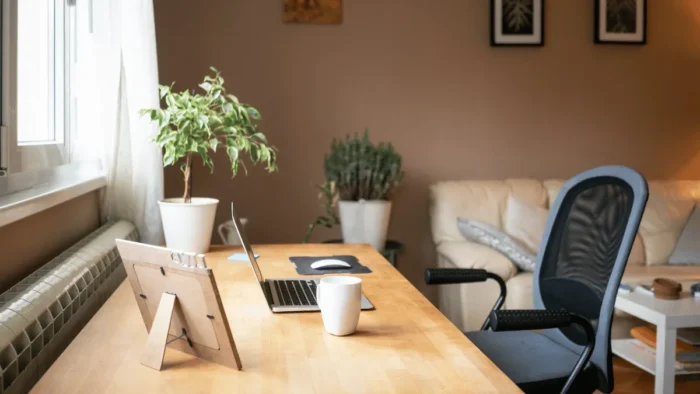In today’s digitally connected world, the home office concept has become increasingly relevant and critical to productivity. With a significant shift towards remote work, creating a comfortable and efficient home office is a necessity and a vital component of balancing work and personal life.
A well-designed home office can enhance productivity, foster creativity, and mitigate the stress often associated with professional tasks. This document aims to guide you through the process of designing an ideal home office by discussing important aspects such as ergonomic furniture, appropriate lighting, noise control, and organized workspace.
We will delve into each of these elements in detail to help you create a workspace that is aesthetically pleasing and fosters a conducive environment for sustained focus and productivity.
Converting Your Garage Space
As an initial step, consider converting your garage into a home office. This space often goes underutilized and can be transformed into an efficient workspace with proper planning and design. The garage offers the advantage of being separate from the main living area, reducing distractions and facilitating focus on work. Ensure proper insulation, ventilation, and heating to ensure comfort in all seasons.
For example, you could utilize a shipped garage cabinet system to store your equipment and supplies, ensuring a clutter-free workspace. Additionally, installing soundproofing materials can minimize external noise and create a quiet environment conducive to work. Of course, if you do not have a garage or prefer to keep it as is, there are still plenty of tips and tricks for designing an efficient home office within your existing living space.
Ergonomic Furniture
Invest in furniture supporting your body posture and reducing the risk of musculoskeletal problems. An adjustable chair and desk, a monitor at eye level, a keyboard and mouse within easy reach, and a footrest can significantly augment comfort and productivity. When selecting a chair, ensure it has proper lumbar support and adjustable armrests.
A standing desk can also be beneficial for switching between sitting and standing positions throughout the day. Furthermore, consider incorporating ergonomic accessories such as wrist pads, document holders, and monitor arms to prevent strain on your wrists, neck, and eyes. In addition to physical comfort, ergonomic furniture can improve your overall well-being by promoting good posture and reducing fatigue.
Appropriate Lighting in Your Home Office
Ensure your workspace is well-lit, preferably with an abundance of natural light. If natural light is not available, install full-spectrum lights that mimic daylight. Proper lighting reduces eye strain and improves focus. Additionally, consider utilizing task lighting for specific work areas, such as a desk lamp for reading or a floor lamp for ambient lighting.
Avoid harsh overhead lighting that can cause glare on screens and create an uncomfortable environment. In addition to functional lighting, incorporating plants in your workspace can also improve the overall ambiance and increase oxygen levels, enhancing productivity. For those with limited access to natural light, consider using a daylight lamp or investing in a light therapy box to mimic the effects of sunlight.

Noise Control
To minimize distractions, consider soundproofing your workspace or using noise-cancelling headphones. If your home office is in a high-traffic area, try implementing a quiet policy during your working hours. Additionally, incorporating soft furnishings such as curtains, rugs, and acoustic panels can absorb excess noise and create a peaceful environment. If you work from home with children or pets present, establish designated quiet zones to minimize interruptions and maintain focus.
Noise control is crucial for achieving a conducive environment for work and can significantly enhance productivity. Over time, you may require less external noise control as your mind becomes accustomed to the new work environment. If working with others, consider implementing a shared sound control policy to meet everyone’s comfort and needs.
Organized Home Office Workspace
Keep your workspace tidy and clutter-free. Storage solutions such as filing cabinets, desk organizers, and shelves are used to store documents, stationery, and other work-related items. An organized space promotes productivity and reduces stress. Additionally, incorporating personal touches such as plants, photos, and artwork can add comfort and familiarity to your workspace. However, be mindful not to clutter your desk with too many personal items that can become distractions.
Keep your desk clear for work-related tasks and designate specific spaces for personal items. Finally, establish a cleaning routine to keep your workspace in order and maintain a conducive environment for work.
Conclusion
In conclusion, designing an efficient home office involves carefully planning and considering essential elements such as ergonomic furniture, appropriate lighting, noise control, and an organized workspace. By implementing these tips and tricks, you can create a comfortable and efficient home office that enhances productivity while promoting overall well-being. Remember to regularly reassess and make necessary adjustments to ensure your home office remains an optimal workspace for your needs.
With the right design and mindset, you can perfectly balance work and personal life in the comfort of your home. So, keep these tips in mind as you create your ideal home office space, and watch as it transforms into a hub of productivity and inspiration.





